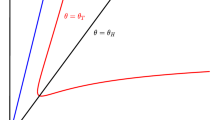Abstract
Our aim in this paper is to investigate the behavior of pattern formation for a predator-prey model with social behavior and spatial diffusion. Firstly, we give some solution behavior where the non-existence of a non-constant steady state solution has been proved for some values of the diffusion coefficients. On the other hand, by using the Leray-Schauder degree theory the existence of the non-constant steady-state solution has been proved under a suitable conditions on the diffusion coefficients.




Similar content being viewed by others
References
Ajraldi, V., Pittavino, M., Venturino, E.: Modeling herd behavior in population systems. Nonlinear Anal., Real World Appl. 12(4), 2319–2338 (2011)
An, Q., Jiang, W.: Turing-Hopf bifurcation and spatio-temporal patterns of a ratio-dependent Holling-Tanner system with diffusion (2017). arXiv:1711.02787 [math.DS]
Boudjema, I., Djilali, S.: Turing-Hopf bifurcation in Gauss-type model with cross diffusion and its application. Nonlinear Stud. 25(3), 665–687 (2018)
Braza, A.P.: Predator-prey dynamics with square root functional responses. Nonlinear Anal., Real World Appl. 13, 1837–1843 (2012)
Cagliero, E., Venturino, E.: Ecoepidemics with infected prey in herd defense: the harmless and toxic cases. Int. J. Comput. Math. 93, 108–127 (2016)
Cao, X., Jiang, W.: Turing-Hopf bifurcation and spatiotemporal patterns in a diffusive predator-prey system with Crowley-Martin functional response. Nonlinear Anal., Real World Appl. 43, 428–450 (2018)
Djilali, S.: Herd behavior in a predator-prey model with spatial diffusion: bifurcation analysis and Turing instability. J. Appl. Math. Comput. 58(1–2), 125–149 (2017)
Djilali, S.: Impact of prey herd shape on the predator-prey interaction. Chaos Solitons Fractals 120, 139–148 (2019)
Djilali, S.: Effect of herd shape in a diffusive predator-prey model with time delay. J. Appl. Anal. Comput. 9(2), 638–654 (2019)
Djilali, S., Touaoula, T.M., Miri, S.E.H.: A heroin epidemic model: very general non linear incidence, treat-age, and global stability. Acta Appl. Math. 152(1), 171–194 (2017)
Guo, S.: Bifurcation and spatio-temporal patterns in a diffusive predator-prey system. Nonlinear Anal., Real World Appl. 42, 448–477 (2018)
Holling, C.S.: The functional response of invertebrate predator to prey density. Mem. Entomol. Soc. Can. 45, 3–60 (1965)
Jia, Y., Luo, B., Wu, J., Xu, H.K.: Analysis on the existence of a steady-states for an ecological-mathematical model with predator-prey-dependent functional response. Comput. Math. Appl. 76(7), 1767–1778 (2018)
Li, S., Wu, J., Dong, Y.: Effects of a degeneracy in a diffusive predator-prey model with Holling II functional response. Nonlinear Anal., Real World Appl. 43, 78–95 (2018)
Liu, B., Wu, R., Chen, L.: Patterns induced by supper cross-diffusion in a predator-prey system with Michaelis-Menten type harvesting. Math. Biosci. 298, 71–79 (2018)
Liu, F., Yang, R., Tang, L.: Hopf bifurcation in a diffusive predator-prey model with competitive interference. Chaos Solitons Fractals 120, 250–258 (2019)
Lou, Y., Ni, W.M.: Diffusion, self-diffusion and cross diffusion. J. Differ. Equ. 131, 79–131 (1996)
Meng, Q., Yang, L.: Steady state in a cross-diffusion predator-prey model with the Beddington-DeAngelis functional response. Nonlinear Anal., Real World Appl. 45, 401–413 (2019)
Oeda, K., Kuto, K.: Positive steady states for a prey-predator model with population flux by attractive transition. Nonlinear Anal., Real World Appl. 44, 589–615 (2018)
Peng, R., Yi, F.q., Zhao, X.q.: Spatiotemporal patterns in a reaction-diffusion model with Degn-Harrison reaction scheme. J. Differ. Equ. 254, 2465–2498 (2013)
Song, Y., Jiang, H., Liu, Q-X., Yuan, Y.: Spatiotemporal dynamics of a diffusive Mussel-Algae model near Turing-Hopf bifurcation. SIAM J. Appl. Dyn. Syst. 16(4), 2030–2062 (2017)
Sun, X., Yuan, R., Wang, L.: Bifurcations in a diffusive predator-prey model with Beddington-DeAngelis functional response and nonselective harvesting. J. Nonlinear Sci. 29(1), 287–318 (2018)
Tang, X., Song, Y.: Cross-diffusion induced spatiotemporal patterns in a predator-prey model with herd behavior. Nonlinear Anal., Real World Appl. 24, 36–49 (2015)
Tang, X., Song, Y.: Bifurcation analysis and Turing instability in a diffusive predator-prey model with herd behavior and hyperbolic mortality. Chaos Solitons Fractals 81, 303–314 (2015)
Tang, X., Stability, Y.S.: Hopf bifurcations and spatial patterns in a delayed diffusive predator-prey model with herd behavior. Appl. Math. Comput. 251(1), 375–391 (2015)
Tang, X., Song, Y., Zhang, T.: Turing-Hopf bifurcation analysis of a predator-prey model with herd behavior and cross-diffusion. Nonlinear Dyn. 86(1), 73–89 (2016)
Tripathi, J.P., Abbas, S., Sun, G.Q., Jana, D., Wang, C.H.: Interaction between prey and mutually interfering predator in prey reserve habitat: pattern formation and the Turing-Hopf bifurcation. J. Franklin Inst. 355(15), 7466–7489 (2018)
Volpert, R.K.Upadhyay.V., Thakur, N.K.: Propagation of Turing patterns in a plankton model. J. Biol. Syst. 6(2), 524–538 (2012)
Wang, Y.peter.H.Pang.M.: Non-constant positive steady states of a predator-prey system with non-monotonic functional response and diffusion. Proc. Lond. Math. Soc. 88(3), 135–157 (2004)
Wang, X., Lutscher, F.: Turing patterns in predator-prey model with seasonality. J. Math. Biol. 78(3), 711–737 (2018)
Wang, C., Qi, S.: Spatial dynamics of a predator-prey system with cross diffusion. Chaos Solitons Fractals 107, 55–60 (2018)
Yang, W.: Effect of cross-diffusion on the stationary problem of a predator-prey system with protection zone. Comput. Math. Appl. 76(9), 2262–2271 (2018)
Yang, R., Zhang, C.: Dynamics in a diffusive predator-prey system with a constant prey refuge and delay. Nonlinear Anal., Real World Appl. 31, 1–22 (2016)
Yang, R., Zhang, C., Zhang, Y.: A delayed diffusive predator-prey system with Michaelis-Menten type predator harvesting. Int. J. Bifurc. Chaos 28(08), 1850099 (2018)
Yao, S-W., Ma, Z-P., Yue, J-L.: Bistability and Turing patterns induced by cross fraction diffusion in a predator-prey model. Physica A 509, 982–988 (2018)
Zhang, T., Liu, X., Meng, X., Zhang, T.: Spatio-temporal dynamics near steady state of a planktonic system. Comput. Math. Appl. 75(12), 4490–4504 (2018)
Zhang, Y., Rong, X., Zhang, J.: A diffusive predator-prey system with prey refuge and predator cannibalism. Math. Biosci. Eng. 16(3), 1445–1470 (2019)
Author information
Authors and Affiliations
Corresponding author
Additional information
Publisher’s Note
Springer Nature remains neutral with regard to jurisdictional claims in published maps and institutional affiliations.
Rights and permissions
About this article
Cite this article
Djilali, S., Bentout, S. Spatiotemporal Patterns in a Diffusive Predator-Prey Model with Prey Social Behavior. Acta Appl Math 169, 125–143 (2020). https://doi.org/10.1007/s10440-019-00291-z
Received:
Accepted:
Published:
Issue Date:
DOI: https://doi.org/10.1007/s10440-019-00291-z




